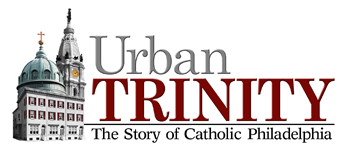 “Urban Trinity: The Story of Catholic Philadelphia” was released just in time for the World Meeting of Families in Philadelphia and it is a keeper. It was shown on WPVI-TV Channel 6 starting in three 25-minute segments, two on Sept. 22, the first day of the families’ congress.
“Urban Trinity: The Story of Catholic Philadelphia” was released just in time for the World Meeting of Families in Philadelphia and it is a keeper. It was shown on WPVI-TV Channel 6 starting in three 25-minute segments, two on Sept. 22, the first day of the families’ congress.
Even if you saw parts one and two, chances are you missed part three, which was shown at the ungodly hour of midnight on Sept. 27, the day Pope Francis wrapped up his visit to Philadelphia and the United States.
Produced by former Philadelphia mayoral candidate Sam Katz, executive producer of Emmy-award winning History Making Productions and in partnership with Channel 6, it relied on the talents of some of the most distinguished scholars in the region in a team headed by Katie Oxx, a professor of religious studies and historian at St. Joseph’s University.
[hotblock]
Compressing 300 years into 75 minutes is no easy task but the film captured some moments that were missed by previously published diocesan histories.
A prime early example is Father Laurence Graessl, a German Jesuit who was one of two Philadelphia priests to die in the great yellow fever epidemic in 1793. Had he lived, he probably would have been Philadelphia’s first bishop, although at the time Baltimore was the only diocese in America.
Baltimore Bishop John Carroll proposed him to Rome as a coadjutor bishop, presumably with residence in Philadelphia, but with the slow transportation of that era, the confirmation of his appointment did not come back until 1794, after his death.
The coverage in “Urban Trinity” of the deaths in 1832 of 57 Irish immigrant railroad laborers laying track at Duffy’s Cut near today’s Immaculata University from cholera (some possibly murdered by locals) doesn’t appear in older histories because it was kept secret by the Philadelphia and Columbia Railroad and its successor, the Pennsylvania Railroad.
It was only in recent years that the tragedy was verified, the site explored by historians and the poor immigrant workers given a proper memorial.
Good coverage is also given to the primarily anti Irish-Catholic Nativist Riots of 1844 which saw St. Augustine and St. Michael churches destroyed and St. Philip Neri Church attacked. It is well to emphasize that sad chapter in Philadelphia history in an era when today’s immigrants are often opposed by some of the very people whose ancestors were not welcomed when they arrived.
What is especially interesting is the writers took great pains to include women who made a difference and the many different ethnicities that make up the Church of Philadelphia.
One of the most formidable Catholic leaders of the 20th century highlighted in the film is Cardinal Dennis Dougherty, who historian Charles Morris dubbed “God’s Bricklayer” for his many building projects.
[hotblock2]
Dougherty comes across as totally against racism, which he was; the authors might also have mentioned he was also one of the few Catholic prelates in his era who did not oppose women’s suffrage.
The film covers Dougherty’s very successful 1934 campaign to clean up the film industry by issuing a ban on Catholics attending movies, which the faithful dutifully observed, and it did work. The film industry cleaned up its act at least for that generation.
It was perhaps a bit of overkill to illustrate this segment with a shot of the Earle Theater being torn down. The Earle, a theater located at 11th and Market streets in Philadelphia which also had live shows, survived Dougherty and closed in 1953. It was a victim of television, not ecclesiastical fiat.
“Urban Trinity” also covers the decline in Catholic power in the city after white flight to the suburbs, partially driven by the factories closing down in the old blue collar Catholic neighborhoods.
Proper attention is also given to the clergy scandals that so wounded the church, and finally the emergence of the new arrivals that bring with them a new vitality.
On the whole “Urban Trinity” is a great documentary and should be a teaching tool for years to come. As of now the film is not available on the urbantrinityfilm.com website, but a Facebook post indicates it will be on the site soon. DVDs may also soon be offered for sale.
PREVIOUS: Philadelphia couple joins Rome synod as marriage experts
NEXT: Saint’s relics travel to Philadelphia on ‘pilgrimage of mercy’



Share this story